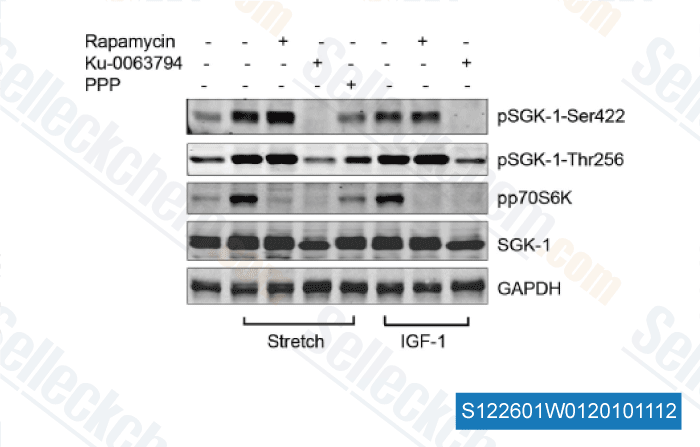|
Toll Free: (877) 796-6397 -- USA and Canada only -- |
Fax: +1-832-582-8590 Orders: +1-832-582-8158 |
Tech Support: +1-832-582-8158 Ext:3 Please provide your Order Number in the email. |
Technical Data
| Formula | C25H31N5O4 |
|||
| Molecular Weight | 465.54 | CAS No. | 938440-64-3 | |
| Solubility (25°C)* | In vitro | DMSO | 16 mg/mL (34.36 mM) | |
| Water | Insoluble | |||
| Ethanol | Insoluble | |||
|
* <1 mg/ml means slightly soluble or insoluble. * Please note that Selleck tests the solubility of all compounds in-house, and the actual solubility may differ slightly from published values. This is normal and is due to slight batch-to-batch variations. * Room temperature shipping (Stability testing shows this product can be shipped without any cooling measures.) |
||||
Preparing Stock Solutions
Biological Activity
| Description | KU-0063794 is a potent and highly specific dual-mTOR inhibitor of mTORC1 and mTORC2 with IC50 of ~10 nM in cell-free assays; no effect on PI3Ks. | ||||
|---|---|---|---|---|---|
| Targets |
|
||||
| In vitro | Compared with the mTOR inhibitor PP242, KU-0063794 exhibits higher specificity for mTOR, as being inactive against PI3Ks or 76 other kinases. In HEK-293 cells, KU-0063794 at 30 nM is sufficient to rapidly ablate S6K1 activity by blocking the phosphorylation of the hydrophobic motif (Thr389) and subsequently the phosphorylation of the T-loop residue (Thr229). In case of IGF1 stimulation of serum-starved HEK-293 cells, 300 nM of KU-0063794 is needed to inhibit the S6K1 activity by ~90%. KU-0063794 at 100-300 nM also completely inhibits the amino-acid-induced phosphorylation of S6K1 and S6 protein. Similar to S6K1, KU-0063794 inhibits the phosphorylation of mTORC1 at Ser2448 and mTORC2 at Ser2481 in a dose-dependent and time-dependent manner. In the presence of serum or following IGF1 stimulation, KU-0063794 induces a dose-dependent inhibition of the activity and phosphorylation of Akt at Ser473 and unexpected Thr308 as well as the phosphorylation of the Akt substrates PRAS40 at Thr246, GSK3α/GSK3β at Ser21/Ser9 and Foxo-1/3a at Thr24/Thr32. KU-0063794 but not rapamycin inhibits SGK1 activity and Ser422 phosphorylation as well as its physiological substrate NDGR1 in a dose-dependent manner, to the same extent as S6K1 and Akt phosphorylation, whereas KU-0063794 dose not inhibit phorbol ester induced ERK or RSK phosphorylation and RSK activation. Compared with rapamycin, KU-0063794 exhibits more significant potency to induce the complete dephosphorylation of 4E-BP1 at Thr37, Thr46 and Ser65. KU-0063794 inhibits cell growth of both wild-type and mLST8-deficient MEFs and induces a G1 cell cycle arrest, more significantly than rapamycin. [1] | ||||
| In vivo | Ku0063794 inhibits tumor growth and mTOR signaling in a preclinical renal cell carcinoma model. However, Ku0063794 was not more effective than temsirolimus in the animal study. A possible explanation for lack of greater activity in vivo for Ku0063794 is that temsirolimus has important effects on the tumor microenvironment. Temsirolimus decreased angiogenesis in the xenograft tumors while Ku0063794 did not. Temsirolimus treated tumors expressed less VEGF and PDGF than Ku0063794 treated tumors, thus stimulating less angiogenesis[2]. |
Protocol (from reference)
| Kinase Assay: |
|
|---|---|
| Cell Assay: |
|
| Animal Study: |
|
References
|
Customer Product Validation

-
Data from [Data independently produced by Oncogene, 2013, 10.1038/onc.2013.509]

-
Data from [J Biol Chem, 2011, 286, 39450-6]

-
Data from [Circ Res, 2010, 107, 1265-1274]

-
, , Dr. Yong-Weon Yi from Georgetown University Medical Center
Selleck's KU-0063794 has been cited by 75 publications
| Resistin secreted by porcine alveolar macrophages leads to endothelial cell dysfunction during Haemophilus parasuis infection [ Virulence, 2023, 14(1):2171636] | PubMed: 36694280 |
| Mechanosensitive mTORC2 independently coordinates leading and trailing edge polarity programs during neutrophil migration [ Mol Biol Cell, 2023, 34(5):ar35] | PubMed: 36857159 |
| Combined Mcl-1 and YAP1/TAZ inhibition for treatment of metastatic uveal melanoma [ Melanoma Res, 2023, 10.1097/CMR.0000000000000911] | PubMed: 37467061 |
| Aggresome assembly at the centrosome is driven by CP110-CEP97-CEP290 and centriolar satellites [ Nat Cell Biol, 2022, 24(4):483-496] | PubMed: 35411088 |
| Inhibition of the Protein Arginine Methyltransferase PRMT5 in High-Risk Multiple Myeloma as a Novel Treatment Approach [ Front Cell Dev Biol, 2022, 10:879057] | PubMed: 35757005 |
| Novel Treatments of Uveal Melanoma Identified with a Synthetic Lethal CRISPR/Cas9 Screen [ Cancers (Basel), 2022, 14(13)3186] | PubMed: 35804957 |
| Jagged-1 is induced by mTOR inhibitors in renal cancer cells through an Akt/ALK5/Smad4-dependent mechanism [ Curr Res Pharmacol Drug Discov, 2022, 3:100117] | PubMed: 35992379 |
| TRK-Fused Gene (TFG), a protein involved in protein secretion pathways, is an essential component of the antiviral innate immune response [ PLoS Pathog, 2021, 17(1):e1009111] | PubMed: 33411856 |
| Effect of cell microenvironment on the drug sensitivity of hepatocellular cancer cells [ Oncotarget, 2021, 12(7):674-685] | PubMed: 33868588 |
| TOR Inhibitors Synergistically Suppress the Growth and Development of Phytophthora infestans, a Highly Destructive Pathogenic Oomycete [ Front Microbiol, 2021, 12:596874] | PubMed: 33935983 |
RETURN POLICY
Selleck Chemical’s Unconditional Return Policy ensures a smooth online shopping experience for our customers. If you are in any way unsatisfied with your purchase, you may return any item(s) within 7 days of receiving it. In the event of product quality issues, either protocol related or product related problems, you may return any item(s) within 365 days from the original purchase date. Please follow the instructions below when returning products.
SHIPPING AND STORAGE
Selleck products are transported at room temperature. If you receive the product at room temperature, please rest assured, the Selleck Quality Inspection Department has conducted experiments to verify that the normal temperature placement of one month will not affect the biological activity of powder products. After collecting, please store the product according to the requirements described in the datasheet. Most Selleck products are stable under the recommended conditions.
NOT FOR HUMAN, VETERINARY DIAGNOSTIC OR THERAPEUTIC USE.
